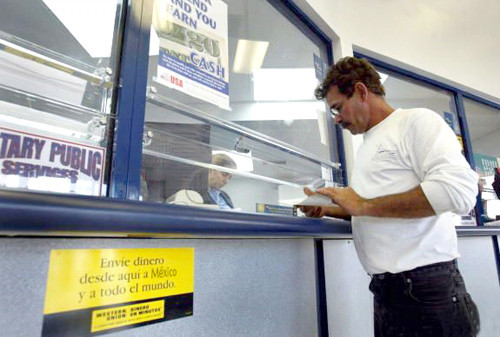Remittances To Latin American Nations, Except Mexico, Recovering To Pre-Recession Levels

Is this light at the end of the tunnel? Remittances sent to Spanish-speaking nations in Latin America by immigrants in the United States and elsewhere have recovered to pre-recession levels, with the notable exception of Mexico.
According to a study by the Pew Research Center, a non-partisan think-tank in Washington, migrant remittances from the U.S. to Mexico will total about $22 billion this year, 29 percent below the 2006 peak. But for all other Spanish-speaking Latin American states (which excludes Brazil), remittances this year will total $31.8 billion, slightly higher than their 2008 peak.
The Pew Center estimated that total remittances from all sources (that is, from migrants in the U.S. as well as other countries) will reach $53.8 billion this year -- a considerable increase compared with the last few years, but still 13 percent lower than the figure recorded in 2007, which saw a record $61.6 billion hauled in. That, not coincidentally, marked the beginning of the Great Recession in the U.S. and other Western nations.
In 2012, the United States was the source of 78 percent of remittances sent to Latin America., while Spain accounted for 8 percent, with Canada at 1 percent.
One of the principal reasons behind the decline in remittances sent to Mexico related to the crash in the construction industry in the U.S., which traditionally employs many Mexicans. Another factor has to do with changes in migration trends, with a decline in the numbers of Mexicans migrating to the U.S. due to fewer employment prospects there. Pew stated that through the end of 2012, migration from the U.S. to Mexico likely equaled or even exceeded the reverse flow.
The Pew Center also noted, however, that Mexico generally accounts for more than 40 percent of all remittances sent to Latin America. According to the World Bank, remittances represent a bigger source of cash for Spanish-speaking Latin America than even foreign aid. In 2011, remittances to Spanish-speaking Latin states totaled some $53.1 billion, more than eight times the total amount of foreign aid to those nations, $6.2 billion.
The importance of remittances differs by country. In most places in Central America, the money sent from abroad (particularly from the U.S., which is relatively nearby) represents a significant chunk of their GDP. For example, remittances accounted for 16.5 percent of El Salvador's GDP in 2012, 15.7 percent of GDP in Honduras and 10 percent of GDP in Guatemala.
However, as one moves further south into South America, the overall weight of remittances decreased: in Argentina, Uruguay and Chile, remittances accounted for less than 1 percent of their GDPs.
Interestingly, Pew suggested that the long-term economic benefits of remittances are inconclusive. The report points out that those countries that depend the most on remittances have a higher number of unemployed – that is, as they are dependent on the money sent from abroad, and remaining family members often give up on their search for work. However, most studies point out that the money is used for practical purposes as groceries, clothes and education.
© Copyright IBTimes 2024. All rights reserved.




















